The beating heart of London is the River Thamesand in 1999 fledgling company Thames Clippers, co-founded by Sean Collins(CEO) and Alan Woods (former Chairman), identified and harnessed the river’s potential as a commuter and leisure highway, an asset that had become underutilised like so many other waterways. The company began with one boat servicing 80 passengers a day between Greenland and Savoy piers. Now, 18 years on, numbers have significantly risen to over 4 million passengers carried in 2016. Making travel by river even easier, passengers have been able to use Oyster pay as you go with Thames Clippers since 2015 and contactless payment methods more recently. The river is thriving with all manner of passenger traffic, larger vessels and more of them.
Five Thames Clippers routes operate between Putney in the west and Royal Arsenal, Woolwich, in the east, with the hub being North Greenwich in the shadow of The 02 with the lay over facilities being across the river from here at Trinity Buoy Wharf. Known currently as MBNA Thames Clippers (MBNA being their 3 year sponsor since 2014 and KPMG was likewise 2011-2014) the company runs a 20 minute frequency service between key London piers including North Greenwich for The 0 2, Greenwich, Canary Wharf, Tower, London Bridge, Westminster and London Eye for Waterloo, as well as several residential piers. In 2006 AEG (Anschutz Entertainment Group), owners and operators of The 0 2, acquired the majority stake in the company and since then the fleet has substantially grown to 17 vessels. River Bus Express for The 02 is an additional fast direct service between London Eye, and London Bridge to The 02 at North Greenwich on arena event nights. The MBNA Thames Clippers services operate under licence from Transport for London.
In April 2013 the company won the contract to run a River Bus service from Putney to Blackfriars which allows the boats to now additionally stop at Putney, Wandsworth Riverside, Chelsea Harbour and Cadogan Pier, a total of 21 piers across the capital. Thames Clippers started out by employing a trio of FBM Hydrocats built by FBM in Cowes, Isle of Wight. These 60gt, 25m long and 62 seater craft were built in 1991/92 and originally began their working lives on the Thames as the Veritatem, Conrad Chelsea Harbour and OHL Worldwide Express. They then passed to the MoD at Plymouth as the Serco 09/10/11 before passing to Thames Clippers and being renamed Sky/Star/Storm Clipper. A period of rapid growth began in 2005 when the NQEA (Australia) built, 98gt, 138 seater and 32m long River Runner 150 craft Sun Clipper and Moon Clipper arrived (built as Antrim Runner and Down Runner for a Belfast Lough service that did not materialise).
Next came the 181gt, 220 seater and 38m long River Runner 200 Mk2 Hurricane Clipper in 2001. After that the 169gt River Runner 200 Mk2b craft Monson/Cyclone/Tornado/Typhoon Clipper in 2007, from SSC Marine in Australia and sisters of the Hurricane Clipper but lighter. Two more, the Meteor Clipper and Aurora Clipper, arrived in 2008. The naming policy through the fleet was for powerful names with a meteorological resonance and this continues. The company is committed to making the River Thames as accessible to as many people as possible, and supports the Port of London Authority’s Thames Vision of doubling the number of people travelling by river and its target of 20 million commuter and tourist trips every year. By autumn 2017 three piers had been added to the ‘Clippers ‘ network since 2015, namely Plantation Wharf Pier, Westminster Pier and Battersea Power Station Pier.
The Hunt for Newbuilds
In 2014 Thames Clippers had a requirement to expand the fleet following increased demand and the awarding of the Putney service. An order for two 35m long and 150 passenger capacity craft was placed with lncat Tasmania and lncat 075 and 076 were subsequently spawned from the builder’s Hobart Shipyard. Dubbed the Hunt Class, the ferries were designed by Sydney based naval architects One2Three. The lncat Group (lncat being an abbreviation of International Catamarans) evolved from other boat building companies such as Sullivans Cove Ferry Company, formed in 1972 by now Chairman Robert Clifford. International Catamarans was formed in 1977, specialising in fast ferries. The world renowned wavepiercing catama ran concept was developed in 1983 and the rest, as they say, is history. The shipyard is located on Prince of Wales Bay at Derwent Park and features over 70,000m2 of undercover pro duction halls with two dock areas capable of accommodating 6 vessels.
The build took around 7 months with sea trials commencing on 14th July 2015 with delivery commencing in late July by way of a heavy lift ship voyage to the River Thames. The duo arrived in the Pool of London aboard their ship, the 7,138gt/2010 built Antje, on the morning of 19th October 2015 after a 15,000 mile voyage from Tasmania and were carefully craned onto the Thames after a short ceremony. Godmother of the Galaxy Clipper, chairman of British Rowing and Vice Chairman of the British Paralympic Association, AnnamariePhelps, officially launched the craft, while Team GB rower Charlotte Taylor, had the honour of cracking the bottle to launch the Neptune Clipper. The craft had already been christened Galaxy Clipper (Hull 075 ) and Neptune Clipper (Hull 076) when A naming competition was held and the winners were Robert Connelly, from Solihull, and Mary Baldwin, from Worthing. Mr Connelly chose Galaxy after a chocolate bar while Ms Baldwin chose Neptune after them ythological Roman god of water. Both names of course fitted perfectly with the naming policy, regardless of the reasons for the choices! The ferries were primarily ordered to bolster capacity on the RB6 Blackfriars Putney service. Eachweek the Galaxy Clipper and Neptune Clipper were expected to travel 204miles each up and down the River Thames, covering over 74,052miles each in one year. The new arrivals were put in to revenue earning service as soon as crew training and trials had been completed.

The Incat built vessels were described as the first technically advanced and energy efficient river and harbour fast ferries in the world. The 35.37m long ferries have a moulded beam of 8.30m, a moulded hull depth of 2.15m and a draught of 1.03m. The air conditioned passenger cabin is located on one deck, as with the other craft in the fleet, with the wheel house located one deck higher. A total of 150 passengers can be carried with 3-4 crew members. The passenger area is accessed on either side at the bow and at the stern. A small outside deck area is also located aft. Each vessel is 155gt, the net tonnage is 61t and the full load dead weight is 12.24t. However, when fuel and stores etc are added to this calculation, the total loaded dead weight is 15. 13t.The hull construction is marine grade aluminium and the ultra low wash hull form is semi-rounded bilge with symmetric hulls of all welded construction. The hull structure is designed for frequent and repeated berthing at London’s floating piers with particular attention paid to potential contact with obstructions in the water in weather conditions that can reasonably be expected in the area of operation. The design also accommodates the unique tidal conditions of the River Thames. Operating in such a high-profile area as Central London it is important that the vessels have a modern style that is visible to both passengers and potential passengers. Therefore, their appearance is representative of a contemporary rapid passenger ferry operated by a professional company. Marine grade high gloss vinyl wrapping, rather than paint, is applied on external surfaces of the super structure for application of the eye-catching MBNA Thames Clippers livery. As well as the aesthetic benefit wrapping offers there is also a weight-saving advantage with vinyl covering across the vessel being approximately two thirds the weight of required paint applications. Each catamaran is propelled by two resiliently mounted Scania DI16072M marine diesel engines, each rated at 625kW(850bhp) and 2,300rpm. These 16.4litre V8, 4-stroke engines have a bore of 130mm, a stroke of 154mm, acompression ratio of 16.7:1 and weigh 1670kg. The engines drive two ZF2000 gearboxes and two Rolls Royce/Kamewa 40A3 waterjets. On board power is provided by two Kohler 33EF0ZDJ generators. A total of 3,128litres of diesel fuel can be carried in two 1,564litre tanks plus 576litres of fresh water and like wise black water. The service speed exceeds 25knots laden and the maximum speed is 30 knots.
Home Grown At Last
As the need for capacity continued, a long-term goal was achieved by Thames Clippers when an order for two new craft was announced on 11th October 2016. At long last the compa ny had secured two UK built vessels, making it the largest fast passenger ferry order for a UK shipyard in over 25 years. Two Hunt Class Mk2 ferries were ordered for a total of £6.3 million from Wight Shipyard Co., East Cowes, Isle of Wight for delivery in summer 2017. The four newbuilds from lncat and Wight Shipyard represented an impressive 30% increase in overall fleet capacity with £26 million having been invested by MBNA Thames Clippers in their fleet since 2006. Wight Shipyard Co. is Europe’s leading high speed craft and aluminium ship builder and began life as Shemara Refit LLP, itself born out of a unique project to manage the revival of a magnificent motor yacht to her former glory in 2010. Built in 1938 by JI Thornycroft the Shemara was once one of the world’s largest and most famous private yachts. In 2015 the company took over the vacant Columbine Building in East Cowes, birthplace of hovercraft such as the SRN4 and SRN6 plus flying boats prior to that. They secured a contract to build the 40m catamaran Red Jet 6 for Red Funnel Ferries, the first fast ferry to be built in the UK for over 16 years. This was the facility’s first contract, and they delivered her on time and within budget in July 2016. In August 2017 a follow up order for Red Jet 7 was received. The compa ny has also been refitting Thames Clippers’ three FBM Hydrocat ferries. The Star Clipper and Storm Clipper were dealt with in 2016 and the Sky Clipper arrived on site on 4th September 2017. Having the building yard close to the Lloyds and MCA offices is also a bonus when developing designs as representatives can meet face to face. The Hunt Class Mk2 newbuilds were yard nos. 002 and 003 and became Mercury Clipper and Jupiter Clipper. This time the naming competition was staged via Fun Kids digital and online radio and the winner from thousandss of entries was 11-year-old Lennon from Scotland. The new ferries were built side by side in the Columbine Building with the Mercury Clipper being 4-6 weeks ahead of her sister. The build process took around 10 months, creating over 75 new jobs across the Isle of Wight and London in the process.
The Mk2 variants have subtle aesthetic differences to their 2015 sisterships and the aft deck area layout has been rearranged to accommodate up to 12 bicycles. The seating capacity has been increased from 150 to 172 by revising the forward seating specification. These craft will also see use on the RB6 Putney-Blackfriars route with the Battersea Power Station complex being incorporated into this route from autumn 2017. Use of lighter materials means the gross tonnage figure is unaffected by the changes on board the Mk2s. The shallow draught characteristic is essential for low water at upper Thames piers as is the minimal wash at full speed. As with the Mk1 layout, accommodation for the 172 persons is in comfortable Beurteaux Ocean Tourist seating. Panoramic and roof windows maximise opportunities for passengers to enjoy London’s iconic skyline. LCD screens enable seated passengers to view safety messages, service and tourist information and on-board refreshment menus. For convenience, outboard seating is provided with USS points for recharging mobile phones.
Separating the main cabin area from the forward seating space is a kiosk which offers passengers a range of snacks and beverages. The kiosk block is also shared with access to an electronics space and the cabin-top wheelhouse. The wheelhouse is equipped with the latest in electronic, navigation and communication equipment to compl y with the High Speed Craft Code. There are two forward facing adjustable seats with the Captain sitting on the centreline, and the Mate to port. Toilet and baby changing facilities are also provided. After sea trials that began on 9th June the Mercury Clipper made her 200 mile, 10 hour delivery voyage to the River Thames on 21st June and entered service shortly afterwards. The Jupiter Clipper began her trials on 1st August and entered service on 17th August. Another benefit of locally built vessels is that both vessels arrived at their new home fully certified enabling them to enter passenger service within 48 hours of completing their respective delivery voyages.
As the new vessels settled into the now 17-strong fleet, Gravesend commuters received the news that Thames Clippers was coming to town 11th-14th September for a trial service from Gravesend town pier into central London, stopping at Canary Wharf, Tower Pier, Blackfriars and Embankment. The service took passengers from Gravesend to Canary Wharf in just 48 minutes and to Tower Pier in under an hour. The trial period is free but passengers were asked to take part in a survey. The Clipper service will offer many benefits that the train direct into Londoncannot. The morning boat was scheduled to depart Gravesend at 0715 and the return boat left Embankment Pier at 1740. London International Cruise Terminal at Tilbury is also served by Thames Clippers when visiting cruise ships call, whisking cruise tourists into the heart of the city via a route lined with history and iconic landmarks. Hopefully this eastern part of the river will soon come under the ferry operator’s daily network and further investment will see more home grown tonnage in the fleet.
Special thanks must go to Rachel Gaston of Siren Communications PR and Justin Merrigan of Wight Shipyard for the invaluable assistance with information and images.
TECHNICAL SPECIFICATIONS – Hunt Class Mk1 & Mk2
Mk1: Galaxy Clipper/Neptune Clipper
Mk2: Mercury Clipper/Jupiter Clipper
| BUILDER | |
| Mk1 | Incat Pty, Hobart, Tasmania |
| Mk2 | Wight Shipyard, Venture Quays, East Cowes, IoWight, U.K |
| Designer | One2three Naval Architects, Sydney, Australia |
| Operator | Thames Clippers |
| Route | River Thames Services |
| IMO | 9783784/9783796/9820128 & unknown as yet |
| YARD NUMBER | |
| Mk1 | Hull 075 (Galaxy Clipper)/Hull 076 (Neptune Clipper) |
| Mk2 | 002 (Mercury Clipper)/003 (Jupiter Clipper) |
| Classification | Lloyds Register +A1 SSC Passenger Catamaran HSC G1 + LMC |
| Port of Registry | London |
| Flag | United Kingdom |
| Keel Laid | No dates supplied |
| Launched | No dates supplied |
| Delivered | July 2015 (Mk1) & June/August 2017 (Mk2) |
| Service Debut | October 2015 (Mk1) & June/August 2017 (Mk2) |
| Length (Overall) | 35.37m |
| Length (Waterline) | 32.69m |
| Beam | 8.30m |
| Hull Depth Moulded | 2.15m |
| Loaded Draught | 1.03m |
| Main Engines | Two resiliently mounted Scania DI16 072M marine diesel engines each 625kW @ 2100 rpm. |
| Gearboxes | 2x ZF2000 series reversing marine gearboxes, 1.5000:1 reduction ratio |
| Propulsion | 2x Rolls Royce/Kamewa 40A3 waterjets |
| Generators | 2x Kohler 33EF0ZDJ generators (Mk1 vessels) |
| 2x Perkins Sabre 63kW 415v 3 phase 50Hz (Mk2 vessels) | |
| Service Speed | 25 knots |
| Maximum Speed | 30 knots |
| Gross Tonnage | 155 |
| Net Tonnage | 61 (Mk2) |
| Passengers | 150 (Mk1) & 172 (Mk2) |
| Crew | 1x Commander; 1x Mate; 1-2x Cabin Attendant (Max Crew: 4) |
| TANK CAPACITIES | |
| Fuel Oil | 3,128 litres |
| Fresh Water | 576 litres |
| Black Water | 576 litres |

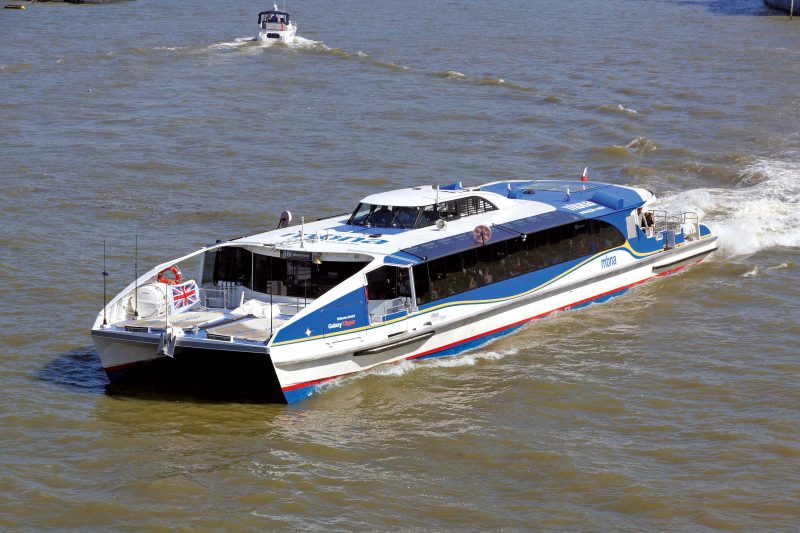
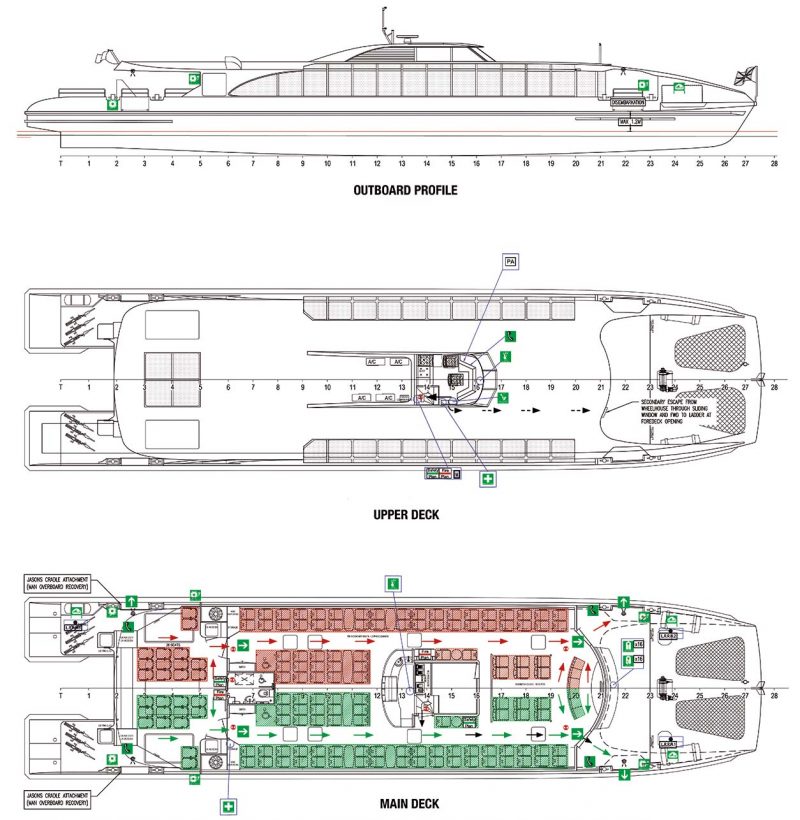
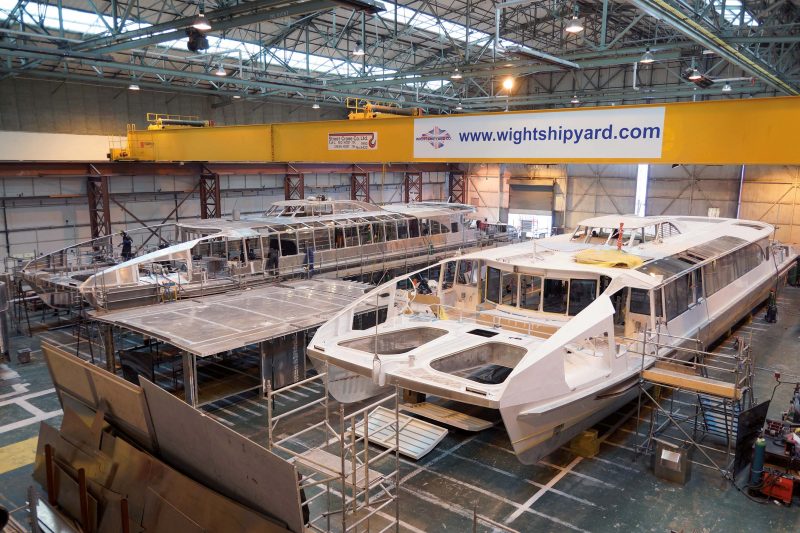
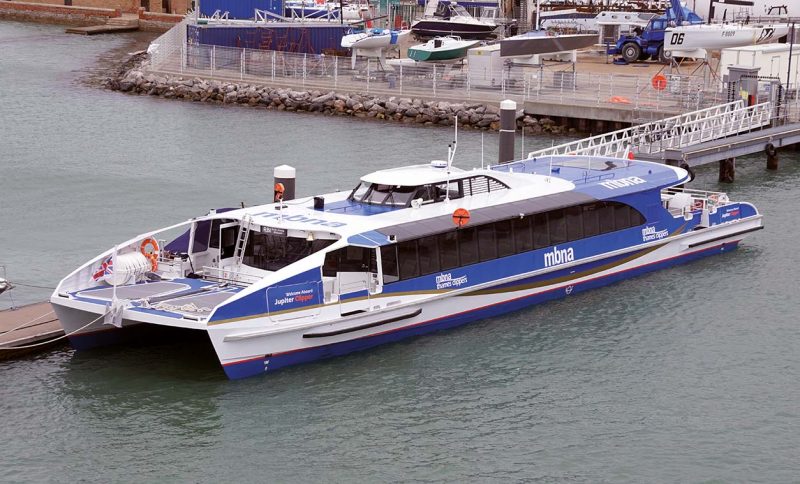
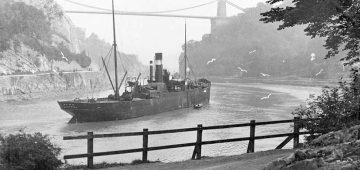



Comments
Sorry, comments are closed for this item